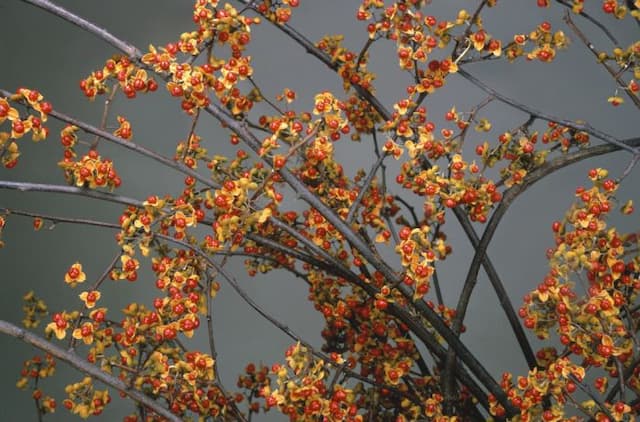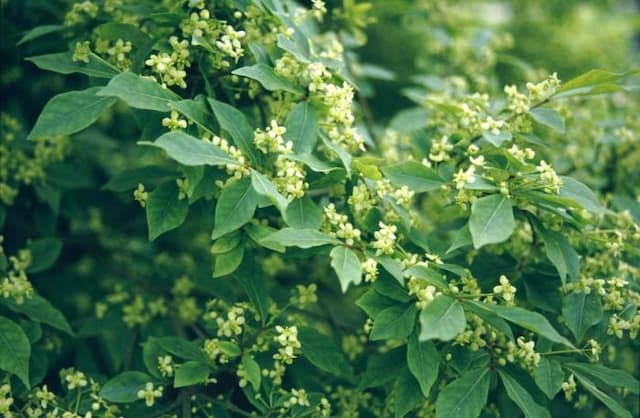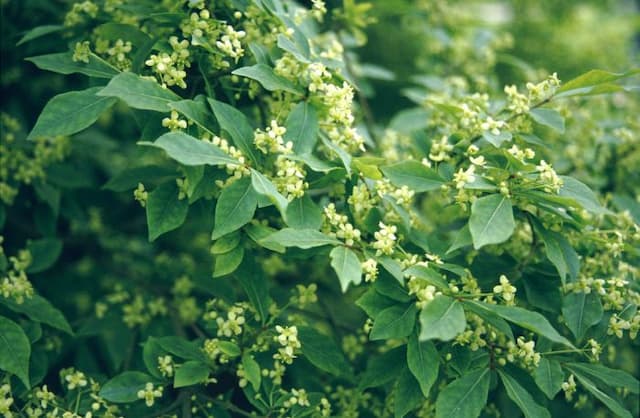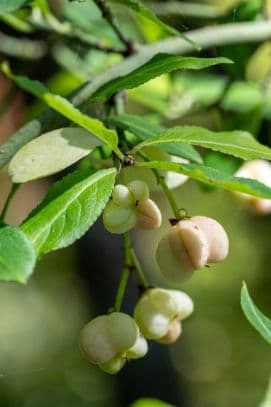Japanese spindle 'Microphyllus Pulchellus' Euonymus japonicus 'Microphyllus Pulchellus' (v)
ABOUT
'Microphyllus pulchellus' is a compact, dense variety with small, oval-shaped glossy dark green leaves with yellow edges. Insignificant green flowers appear late spring to early summer
About this plant
 Names
NamesFamily
Celastraceae
Synonyms
Japanese Spindle, Box-leaf Euonymus, Evergreen Spindle, Japanese Euonymus
Common names
Euonymus japonicus var. microphyllus Maxim.
 Characteristics
CharacteristicsLife cycle
Perennials
Foliage type
Evergreen
Color of leaves
Green
Height
2-3 feet (0.6-0.9 meters)
Spread
2-3 feet (0.6-0.9 meters)
Plant type
Shrub
Hardiness zones
6-9
Native area
Japan
Benefits
 General Benefits
General Benefits- Low maintenance: Requires minimal care once established, making it great for busy gardeners or those who prefer low-maintenance landscapes.
- Drought tolerance: Can withstand periods of low water, beneficial in regions with water restrictions or in xeriscape gardens.
- Evergreen foliage: Offers year-round greenery and visual interest due to its perennial nature.
- Compact growth: Its small leaves and dense growth habit make it suitable for formal hedging and topiary.
- Versatility in landscape design: Can be used in a variety of garden styles including formal, cottage, and contemporary gardens.
- Resilience to pests and diseases: Generally resistant to common garden pests and diseases, reducing the need for chemical treatments.
- Adaptable to various soil types: Tolerates a range of soil conditions from clay to sandy soils.
- Shade tolerance: Capable of growing in partially shaded areas where other sun-loving plants might struggle.
- Coastal suitability: Can tolerate salt spray, which is particularly advantageous for gardens near the ocean.
- Attractive to wildlife: Can provide shelter and nesting sites for birds.
 Medical Properties
Medical PropertiesThis plant is not used for medical purposes.
 Air-purifying Qualities
Air-purifying QualitiesThis plant is not specifically known for air purifying qualities.
 Other Uses
Other Uses- Japanese Spindle is used in topiary gardens due to its small leaves and ease of pruning, making it a good candidate for creating living sculptures and intricate hedge designs.
- The dense foliage of Japanese Spindle provides excellent shelter for small birds and beneficial insects, serving as a mini sanctuary within gardens.
- This plant can be used in bonsai cultivation, allowing enthusiasts to craft miniature landscapes with its compact growth habit.
- Japanese Spindle's wood, being hard and dense, is sometimes used in the creation of fine-quality, small wooden tools or utensils.
- The evergreen nature of the plant offers year-round greenery to gardens, making it an ideal choice for foundational plantings around homes or buildings.
- Japanese Spindle, due to its resilience, can also be utilized for erosion control on slopes or banks, helping to retain soil in place.
- Its foliage can be used in floral arrangements as long-lasting greenery, providing a backdrop for more colorful flowers.
- In coastal areas, Japanese Spindle is planted as a windbreak to protect more delicate plants from sea breezes that can carry salt and sand.
- It can act as a natural privacy screen when planted in rows or clumps, obscuring unwanted views and reducing noise pollution.
- Creative landscaping uses may include shaping Japanese Spindle into a living fence or border along walkways and paths within a garden setting.
Interesting Facts
 Feng Shui
Feng ShuiThe Japanese Spindle is not used in Feng Shui practice.
 Zodiac Sign Compitability
Zodiac Sign CompitabilityThe Japanese Spindle is not used in astrology practice.
 Plant Symbolism
Plant Symbolism- Endurance: Euonymus japonicus, commonly known as Japanese Spindle, has a tough and hardy nature symbolizing resilience and the ability to endure difficult conditions.
- Loyalty: The evergreen nature of this plant signifies faithfulness and unwavering loyalty, as it remains constant throughout the seasons.
- Good Fortune: In some cultures, the Japanese Spindle is considered a bringer of good luck, perhaps due to its association with long-lasting vitality.
- Protection: The dense foliage often used in hedges can symbolize the idea of providing a protective barrier or a safe haven.
 Water
WaterFor a Japanese Spindle (Euonymus japonicus 'Microphyllus Pulchellus'), water deeply but infrequently to encourage a strong root system. Typically, watering once a week during active growth periods in spring and summer is sufficient, providing about 1-2 gallons depending on the size and age of the plant. Reduce watering frequency to every two to three weeks during fall and winter when the plant is dormant. Always check the top inch of the soil for dryness before watering; the soil should be dry to the touch. Avoid overwatering as it can lead to root rot. Water directly at the base of the plant and avoid wetting the foliage to prevent fungal diseases.
 Light
LightThe Japanese Spindle thrives best in full sun to partial shade. An ideal spot would provide bright, indirect sunlight for most of the day with some protection from the intense midday sun, especially in hotter climates. Too much direct sun can scorch the leaves, while too little can lead to leggy growth, so find a balance that suits your specific environment.
 Temperature
TemperatureA Japanese Spindle prefers temperate conditions and can tolerate a range from 30 to 80 degrees Fahrenheit. Ideal growing temperatures are between 60 and 75 degrees Fahrenheit. It can handle occasional dips below freezing, but prolonged exposure to temperatures below 30 degrees Fahrenheit can damage the plant. Protect from extreme cold with mulch or by bringing potted specimens indoors.
 Pruning
PruningPruning the Japanese Spindle is primarily done to maintain shape and encourage dense, bushy growth. It’s best to prune in late winter or early spring before new growth starts. Pruning can be done annually or as needed to remove dead or damaged branches, control size, and improve the overall appearance of the plant. Regular pruning also helps to rejuvenate older plants and maintain plant health.
 Cleaning
CleaningAs needed
 Soil
SoilThe Euonymus, commonly known as Japanese Spindle, thrives in well-drained, loamy soil with a pH ranging from slightly acidic to neutral (pH 6.0-7.0). A soil mix consisting of equal parts garden soil, peat moss, and perlite or coarse sand encourages healthy growth. Ensure the soil is rich in organic matter to provide the necessary nutrients.
 Repotting
RepottingJapanese Spindle should be repotted every two to three years to refresh the soil and allow for root growth. Young plants may require more frequent repotting, while mature plants can be repotted less often if they are not outgrowing their pots.
 Humidity & Misting
Humidity & MistingJapanese Spindle prefers moderate humidity levels. Maintaining indoor humidity around 40-50% is usually adequate for the plant. Avoid extremely low humidity conditions, which can cause leaf browning and crispiness.
 Suitable locations
Suitable locationsIndoor
Place Japanese Spindle in bright, indirect light; water when soil is dry.
Outdoor
Plant in partial shade to full sun; shelter from harsh winds.
Hardiness zone
6-9 USDA
 Life cycle
Life cycleEuonymus japonicus 'Microphyllus Pulchellus', commonly known as the Japanese spindle, begins its life cycle as a seed, typically germinating in a warm, moist environment in spring. Upon germination, the seedling emerges and establishes its roots and a pair of initial leaves for photosynthesis. As the plant grows, it develops a small, compact form with tiny, glossy green leaves, typical of the 'Microphyllus Pulchellus' variety. The Japanese spindle reaches maturity in a few years, during which it can start producing small, inconspicuous greenish-white flowers, usually in late spring to early summer. Following flowering, small, pink to red fruits may form, which change to a more purple shade upon maturity, and they may persist into winter. The plant can live for many years, and maintenance includes regular pruning to maintain its shape and encourage bushier growth.
 Propogation
PropogationPropogation time
Spring-Early Summer
The Japanese Spindle 'Microphyllus Pulchellus' is commonly propagated by semi-hardwood cuttings, which is considered the most popular method. This process typically occurs during the late summer months. To propagate, select healthy, non-flowering stems and cut a segment about 4 to 6 inches long. Remove the leaves from the lower half of the cutting, and dip the cut end into a rooting hormone to encourage growth. The prepared cutting should then be inserted into a pot filled with a mix of peat and perlite or sand. It's important to maintain a consistently moist, but not soggy, environment and provide indirect light until roots have developed, usually within a few weeks. Once rooted, cuttings can be transplanted into individual pots with standard potting soil and grown on until they are ready to be planted out.




![Spindle [Blondy]](/_next/image?url=https%3A%2F%2Fplants-admin.emdemapps.com%2Fimages%2Fplants%2F%2Fimages%2F604b642f54add.png&w=640&q=75)


